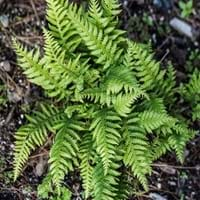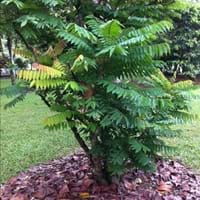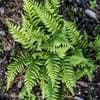Life Span
Perennial
Perennial
Type
Fern
Flowering Plants, Herbs
Origin
Eastern Asia
Hybrid origin
Types
Not Available
Not Available
Number of Varieties
Not Available
Habitat
Damp shady woods, Wet ground, Wet lands
moist forests, Mountains
USDA Hardiness Zone
7-8
4-9
Sunset Zone
4
1a, 1b, 2a, 2b, 3a, 3b, 4, 5, 6, 7, 8, 9, 10, 11, 12, 13, 14, 15, 16, 17, 18, 19, 20
Habit
Arching/Fountain-shaped
Clump-Forming
Flower Color
Non Flowering Plant
Purple, Pink, Lavender
Flower Color Modifier
Bicolor
Bicolor
Fruit Color
Non Fruiting Plant
Brown
Leaf Color in Spring
Light Green
Green
Leaf Color in Summer
Light Green
Green
Leaf Color in Fall
Light Green
Green
Leaf Color in Winter
Not Available
Green
Leaf Shape
Pinnate
Pinnate
Plant Season
Spring, Summer, Fall
Spring, Summer
Sunlight
Full Sun, Partial shade
Full Sun
Type of Soil
Clay, Loam
Clay, Loam, Sand
The pH of Soil
Acidic, Neutral
Acidic, Neutral, Alkaline
Soil Drainage
Average
Well drained
Bloom Time
Fall, Spring, Summer
Late Spring, Summer
Tolerances
Wet Site
Drought, Salt
Where to Plant?
Container, Ground, Pot
Ground
How to Plant?
From Rhizomes
Cuttings, Seedlings
Plant Maintenance
Medium
Medium
Watering Requirements
Water Deeply, Water in morning to avoid prompting diseases, Water occasionally, Water slowly, and allow to dry completely between soakings
Needs very little water
In Summer
Lots of watering
Lots of watering
In Spring
Moderate
Moderate
In Winter
Average Water
Average Water
Soil pH
Acidic, Neutral
Acidic, Neutral, Alkaline
Soil Type
Clay, Loam
Clay, Loam, Sand
Soil Drainage Capacity
Average
Well drained
Sun Exposure
Part sun, Partial shade, Partial Sun
Full Sun
Pruning
Remove damaged leaves, Remove dead branches, Remove dead leaves
cut main trunk every 5 years, Prune after flowering, Prune central stem, Remove damaged leaves, Remove dead branches, Remove dead leaves
Fertilizers
All-Purpose Liquid Fertilizer, Apply N-P-K
All-Purpose Liquid Fertilizer, Apply 5-10-5 amounts, Compost
Pests and Diseases
Leaf curl, Leaf rust, Red blotch, Scale, Scale insects
Nematodes, Red blotch, Trunk Rot
Plant Tolerance
Drought, Humidity, Rocky Soil, Shade areas, Wet Site
Drought
Flower Petal Number
Single
Single
Foliage Texture
Medium
Medium
Foliage Sheen
Matte
Glossy
Attracts
Butterflies
Butterflies, Leaf Hoppers
Allergy
Not Available
Itchiness, Not Available, Sore Throat
Aesthetic Uses
Bog Garden, Borders
Beautification
Beauty Benefits
Not Available
Anti-ageing, Good Cleanser, Remove blemishes, Removes pimples
Environmental Uses
Air purification
Air purification, Food for animals, Food for birds, soil stabilisation
Medicinal Uses
Not Available
Cough, Haemorrhages, Laxative, Obesity, Tonic
Part of Plant Used
Not Available
Fruits, Leaves
Other Uses
Not Available
Added to salads, Can be boiled and seasoned, pickled, Culinary use
Used As Indoor Plant
Yes
No
Used As Outdoor Plant
Yes
Yes
Garden Design
Bog Garden, Groundcover, Mixed Border, Rock Garden, Wall, Tropical
Container, Cutflower, Mixed Border, Rock Garden / Wall, Wildflower
Botanical Name
THELYPTERIS decursive pinnata
Averrhoa bilimbi
Common Name
Beech Wood Fern
Winged Beech Fern
Bilimbi, Mimbro
In Hindi
Japanese Beech Fern
Bilimbi
In German
Japanische Buche Fern
bilimbi
In French
Japanese Beech Fern
bilimbi
In Spanish
Helecho de haya japonesa
bilimbi
In Greek
Ιαπωνικά Οξιά Fern
bilimbi
In Portuguese
Japonês Beech Fern
bilimbi
In Polish
Japoński Buk Fern
bilimbi
In Latin
Phlox Italica
Rondo Beardtongue
Phylum
Angiosperms
Magnoliophyta
Class
Polypodiopsida
Magnoliopsida
Order
Polypodiales
Oxalidales
Family
Thelypteridaceae
Oxalidaceae
Genus
Thelypteris
Averrhoa
Clade
Not Available
Angiosperms, Eudicots, Rosids
Tribe
Not Available
Not Available
Subfamily
Not Available
Not Available
Number of Species
Not Available
Importance of Japanese Beech Fern and Bilimbi
Want to have the most appropriate plant for your garden? You might want to know the importance of Japanese Beech Fern and Bilimbi. Basically, these two plants vary in many aspects. Compare Japanese Beech Fern and Bilimbi as they differ in many characteristics such as their life, care, benefits, facts, etc. Every gardener must at least have the slightest clue about the plants he wants to plant in his garden. Compare their benefits, which differ in many ways like facts and uses. The medicinal use of Japanese Beech Fern is Not Available whereas of Bilimbi is Cough, Haemorrhages, Laxative, Obesity and Tonic. Japanese Beech Fern has beauty benefits as follows: Not Available while Bilimbi has beauty benefits as follows: Not Available.
Compare Facts of Japanese Beech Fern vs Bilimbi
How to choose the best garden plant for your garden depending upon its facts? Here garden plant comparison will help you to solve this query. Compare the facts of Japanese Beech Fern vs Bilimbi and know which one to choose. As garden plants have benefits and other uses, allergy is also a major drawback of plants for some people. Allergic reactions of Japanese Beech Fern are Not Available whereas of Bilimbi have Itchiness, Not Available and Sore Throat respectively. Having a fruit bearing plant in your garden can be a plus point of your garden. Japanese Beech Fern has no showy fruits and Bilimbi has no showy fruits. Also Japanese Beech Fern is not flowering and Bilimbi is not flowering . You can compare Japanese Beech Fern and Bilimbi facts and facts of other plants too.



